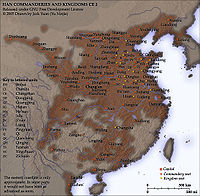- Lelang Commandery
-
Lelang Commandery Chinese name Traditional Chinese 樂浪郡 Simplified Chinese 乐浪郡 Transcriptions Mandarin - Hanyu Pinyin Lèlàng Jùn Korean name Hangul 낙랑군
(DPRK: 락랑군)Hanja 樂浪郡 Transcriptions - Revised
RomanizationNangnang-gun
(DPRK: Rakrang-gun)- McCune-
ReischauerNangnang-kun
(DPRK: Rakrang-kun)Lelang was one of the Chinese commanderies which was established after the fall of Gojoseon in 108 BC until Goguryeo conquered it in 313. Lelang Commandery was located in the northern Korean peninsula with the administrative center near modern P'yongyang[1].
Contents
History
In 108 BC, Emperor Wu of the Han Dynasty conquered the area under King Ugeo, a grandson of King Wiman. The Emperor set up Lelang, Lintun, Xuantu and Zhenfan, known as the Four Commanderies of Han in the the northern Korean peninsula and Liaodong peninsula. The Book of Han records Lelang belonged to Youzhou, located in northwestern Gojoseon consisted of 25 prefectures, 62,812 houses, and the population was 406,748.[2] Its capital was located Nakrang-guyok, P'yŏngyang. (Rakrang 樂浪/락랑 is a district in central P'yŏngyang today.)[3] Though disputed by North Korean scholars, Western sources generally describe the Lelang Commandery as existing within the Korean peninsula, and extend the rule of the four commanderies as far south as the Han River in the Korean peninsula[4][5].
After Emperor Wu's death, Zhenfan and Lintun were abolished and Xuantu was moved to Liaodong. Some prefectures of the abolished commanderies were incorporated into Lelang. Lelang after the consolidation is sometimes called "Greater Lelang commandery". Since Lelang became too large for a commandery, the Defender of the Southern Section (南部都尉) was set up to rule the seven prefectures which formerly belonged to Zhenfan. Before that, the Defender of the Eastern Section (東部都尉) was put to rule former Lintun's seven prefectures.
An influx of immigrants, mainly from the Yan (Hebei) and Qi (Shandong) provinces, continued without cessation, implanting Chinese culture into the former Gojoseon area. The Yan people came from the Yan area, around what is now Beijing, via Liaodong; and the Qi people came across the Yellow Sea. Among them, the Wang clan, whose ancestor is said to have fled there from Qi in the 2nd century BC, became powerful. It is presumed that most of the Lelang Chinese spoke the Yan dialect.
While the Han Dynasty was taken over by Wang Mang, China fell into chaos. Wang Tiao (王調) started a rebellion and tried to secede from China. In 30 AD, the rebellion was stopped by Wang Zun (王遵), whom Emperor Guangwu appointed as governor. Lelang came under the direct control of China once again. However, the shortages of human resources caused by the turmoil resulted in the abolishment of the seven eastern prefectures. The administration was left to the Hui (濊) natives, whose chiefs were conferred as marquisate.
At the end of the Eastern Han Dynasty, Gongsun Du, appointed as the Governor of Liaodong in 184, extended his semi-independent domain to the Lelang and Xuantu commanderies. His son Gongsun Kang separated the southern half from the Lelang commandery and established the Daifang commandery in 204. As a result, the Lelang commandery reverted to its original size.
In 236, under the order of Emperor Ming of Cao Wei, Sima Yi crushed the Gongsun family and annexed Liaodong, Lelang and Daifang to Wei. Lelang was inherited by the Jin Dynasty. Due to bitter civil wars, Jin became unable to control the Korean peninsula at the beginning of the 4th century. Zhang Tong (張統) broke away from Jin in Lelang and Daifang. After Luoyang, the capital of Jin, was occupied by the Xiongnu in 311, he went for help to Murong Hui, a Xianbei warlord, with his subjects. Murong Hui put another small Lelang commandery in Liaodong. The former Lelang was then annexed by Goguryeo.
See also
- List of China-related topics
- History of China
- Four Commanderies of Han
- Xuantu Commandery
- Daifang commandery
- List of Korea-related topics
- History of Korea
References
- ^ Carter J. Eckert, el., "Korea, Old and New: History", 1990, pp. 14
- ^ 前漢書卷二十八地理志第八 "樂浪郡,武帝元封三年開。莽曰樂鮮。屬幽州。戶六萬二千八百一十二,口四十萬六千七百四十八。有雲鄣。縣二十五:朝鮮,讑邯,浿水,水西至增地入海。" Wikisource: the Book of Han, volume 28-2
- ^ ROBERT WILLOUGHBY (2008). BRADT TRAVEL GUIDE NORTH KOREA, THE. Bradt Travel Guides. p. 7. ISBN 1841622192. http://books.google.com/books?id=-bHkI4cEc1QC&pg=PA8&dq=chinese+official's+tombs+dotted+around+modern+pyongyang+contained+paintings#v=snippet&q=the%20biggest%20commandery%20free%20with%20%20four%20under%20population%20tuman&f=false. Retrieved 2011-01-09.
- ^ Carter J. Eckert, el., "Korea, Old and New: History", 1990, pp. 13
- ^ http://www.shsu.edu/~his_ncp/Korea.html
External links
Categories:- Han Dynasty
- Cao Wei
- Jin Dynasty
- Former Yan
- Early Korean history
Wikimedia Foundation. 2010.

